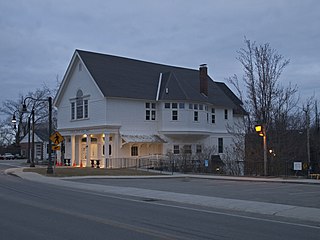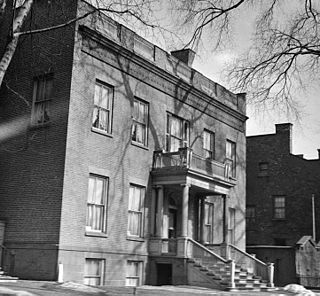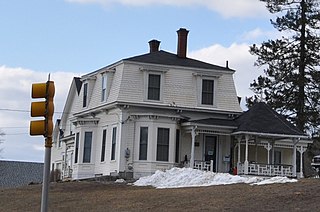
The Senator William P. Frye House is a historic house on 453-461 Main Street in Lewiston, Maine. Built in 1874, it is a fine example of Second Empire architecture in the city, designed by local architects Fassett & Stevens for William P. Frye, a mayor of Lewiston and a United States Senator. The house was listed on the National Register of Historic Places in 1976.

The First Universalist Church is a historic church building on the corner of Pleasant, Elm, and Spring Streets in Auburn, Maine. It was built in 1876 to a design by John Stevens of Boston, Massachusetts, and has been a significant landmark in the city since its construction. It is a fine local example of Gothic Revival architecture executed in brick, and was listed on the National Register of Historic Places in 1979.

The Francis Parkman House is a National Historic Landmark at 50 Chestnut Street, on Beacon Hill in Boston, Massachusetts. Speculated to be designed by Cornelius Coolidge and built in 1824, it is one of a series of fine brick townhouses on Beacon Hill. Its significance lies in its ownership and occupancy by noted historian and horticulturalist Francis Parkman (1823–1893) from 1865 until his death. While living here, Parkman produced a significant portion of his landmark work, France and England in North America, a multi-volume epic history recounting the conflict for control of North America in the 17th and 18th centuries.

The Old Faithful Historic District in Yellowstone National Park comprises the built-up portion of the Upper Geyser Basin surrounding the Old Faithful Inn and Old Faithful Geyser. It includes the Old Faithful Inn, designed by Robert Reamer and is itself a National Historic Landmark, the upper and lower Hamilton's Stores, the Old Faithful Lodge, designed by Gilbert Stanley Underwood, the Old Faithful Snow Lodge, and a variety of supporting buildings. The Old Faithful Historic District itself lies on the 140-mile Grand Loop Road Historic District.

The Lorenzo D. Hawkins House is a historic house at 1 Cedar Street in Stoneham, Massachusetts. The property consists of a house and carriage house, both built c. 1870, that are among Stoneham's finest Second Empire buildings. The house is a two-story wood-frame structure with irregular massing. It has the classic mansard roof, an ornately decorated entry porch, heavily bracketed cornice, and round-arch windows in its dormers and front bay. The carriage house features a polychrome mansard roof.

The Lucius Knowles House is a historic house located at 838 Main Street in Worcester, Massachusetts. It is locally significant as one of the city's best preserved Second Empire style buildings.

The William Austin House is a historic house located at 34 Seneca Street in Trumansburg, Tompkins County, New York.

The Glover House, also known as the Budd House, is a historic house at 50 Main Street in Newtown, Connecticut. Built in 1869, it is a good local example of Second Empire architecture, and is further notable for the long tenancy of a single prominent local family. It was listed on the National Register of Historic Places in 1982.

The Linden Apartments are a historic multiunit apartment house at 10–12 Linden Pl. in Stamford, Connecticut. It is a 2+1⁄2-story wood-frame Second Empire style building with a mansard roof, and projecting window bays. Built in 1886, it is the most architecturally distinctive tenement house in the city, and is its oldest surviving six-unit building. It was probably built by George Hoyt, one Stamford's leading 19th-century real estate developers.

The Eaton School, in Norridgewock, Maine, also known as Somerset Grange #18, is a historic community building at Main Street and Mercer Road in Norridgewock, Maine. Originally built in 1866–67 to house a private academy and the local Masonic lodge, it is notable as an early design of Charles F. Douglas, a Maine native whose career began in Somerset County. The building is a fine local example of Second Empire design, and was listed on the National Register of Historic Places in 1988. It has been owned since 1916 by the local chapter of the Grange.

Farmington is a house near Charlottesville, in Albemarle County, Virginia, that was greatly expanded by a design by Thomas Jefferson that Jefferson executed while he was President of the United States. The original house was built in the mid-18th century for Francis Jerdone on a 1,753-acre (709 ha) property. Jerdone sold the land and house to George Divers, a friend of Jefferson, in 1785. In 1802, Divers asked Jefferson to design an expansion of the house. The house, since greatly enlarged, is now a clubhouse.

The U.S. Post Office, located at 65 W. Mill Ave., is the main post office in Porterville, California. Built from 1933 to 1937, the post office was designed by H. Rafael Lake in the Art Deco style. The design features decorative terra cotta plaques over the windows and cast aluminum plaques below the front windows, decorative features used in no other building in Porterville. A terra cotta frieze atop the front entry features eagle and acanthus motifs borrowed from Roman designs and a sunrise pattern typical of Art Deco decorations. The building is topped with a green tile roof, an unusual element in Art Deco buildings which is consistent with the vernacular Mission Revival style common in Porterville architecture. The post office is one of three Art Deco post offices remaining in California.

The Dublin Town Hall is the seat of municipal government of Dublin, New Hampshire, prominently located at 1120 Main Street in the village center. Built in 1883 and redesigned in 1916, it is architecturally a prominent local example of Colonial Revival architecture with some Shingle style details. It was listed on the National Register of Historic Places in 1980.

The Dr. Hun Houses were located on Washington Avenue on the western edge of central Albany, New York, United States. They were a pair of brick buildings constructed a century apart, the older one around 1830, in the Federal style. In 1972, three months after they were listed on the National Register of Historic Places, they were demolished and subsequently delisted.

The Reuben Foster House and Perley Cleaves House are a pair of nearly identical Greek Revival houses at 64 and 62 North State Street in Concord, New Hampshire. Built 1848-1850, they are among New Hampshire's best examples of Greek Revival architecture, having undergone only relatively modest alterations. The houses were listed on the National Register of Historic Places in 1982. The Cleaves House is further notable for its association with Mary Baker Eddy, and now serves as a historic house museum.

The Charles S. Hall House is a historic house at 1740 Dover Road in Epsom, New Hampshire. Built c. 1890, it is the only Second Empire building in the town, adorned further with Queen Anne features. The house was listed on the National Register of Historic Places in 2002.

The Town Hall of Sandwich, New Hampshire, is located at 8 Maple Street in the village of Center Sandwich. Built in 1913, it is a handsome example of Colonial Revival architecture, and has been a prominent focal point of the town's civic and social life since its construction. The building was listed on the National Register of Historic Places in 1980.

The Spur House is a historic house off Old Common Road in Dublin, New Hampshire. Built in 1901, it is a good local example of Colonial Revival architecture, designed by architect Charles A. Platt. The house was listed on the National Register of Historic Places in 1983.

The G.O. Sanders House is a historic house at 10 Derry Street in the center of Hudson, New Hampshire. Built in 1873-75 by George Sanders, this 2+1⁄2-story wood-frame house is a well-preserved example of French Second Empire style. It was listed on the National Register of Historic Places in 1986.

The Blake House is a historic house at 107 Court Street in Bangor, Maine. Built in 1858 to a design by local architect Calvin Ryder, it is one of the first Second Empire houses to be built in the state of Maine. It was listed on the National Register of Historic Places on October 31, 1972.
























